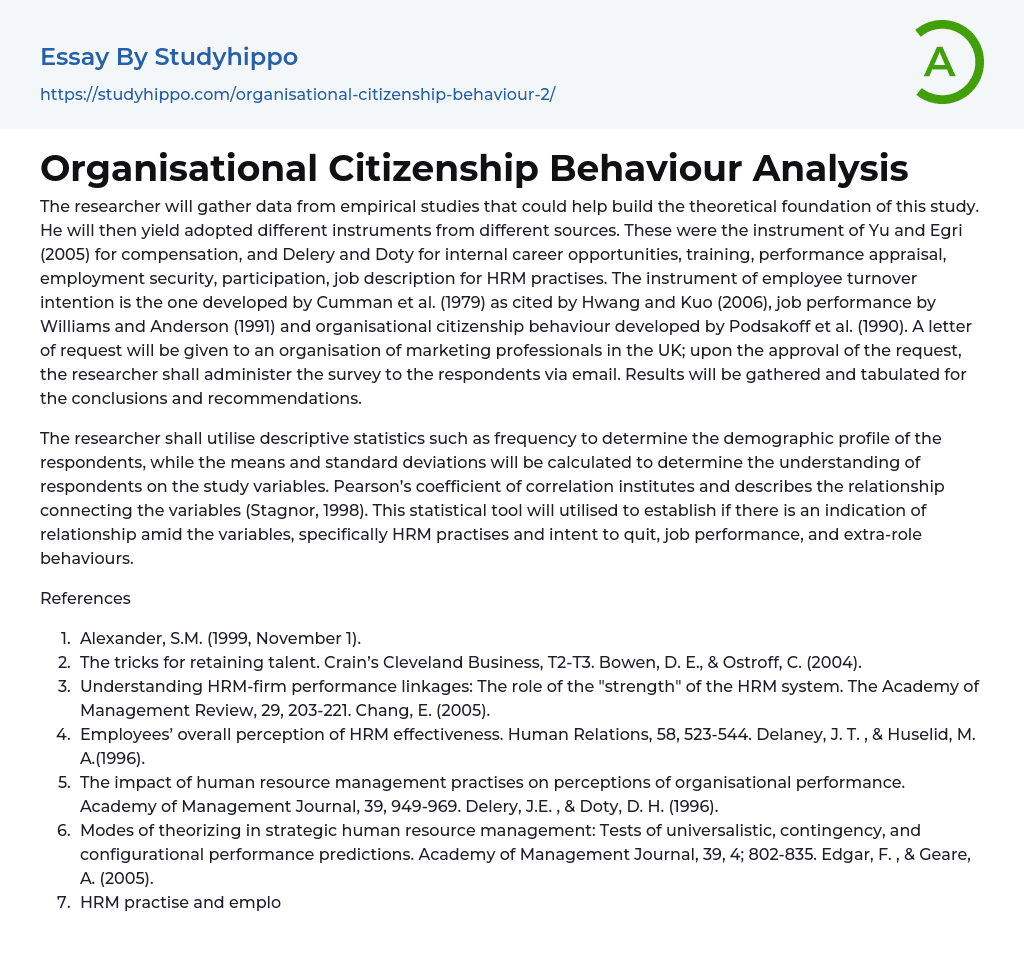

Organisational Citizenship Behaviour Analysis Essay Example
The researcher will gather data from empirical studies that could help build the theoretical foundation of this study. He will then yield adopted different instruments from different sources. These were the instrument of Yu and Egri (2005) for compensation, and Delery and Doty for internal career opportunities, training, performance appraisal, employment security, participation, job description for HRM practises. The instrument of employee turnover intention is the one developed by Cumman et al. (1979) as cited by Hwang and Kuo (2006), job performance by Williams and Anderson (1991) and organisational citizenship behaviour developed by Podsakoff et al. (1990). A letter of request will be given to an organisation of marketing professionals in the UK; upon the approval of the request, the researcher shall administer the survey to the respondents via email. Results will be gathered and tabulated for the conclusions and recommendations.
The researcher shall utilise descriptive statistics su
...ch as frequency to determine the demographic profile of the respondents, while the means and standard deviations will be calculated to determine the understanding of respondents on the study variables. Pearson’s coefficient of correlation institutes and describes the relationship connecting the variables (Stagnor, 1998). This statistical tool will utilised to establish if there is an indication of relationship amid the variables, specifically HRM practises and intent to quit, job performance, and extra-role behaviours.
References
- Alexander, S.M. (1999, November 1).
- The tricks for retaining talent. Crain’s Cleveland Business, T2-T3. Bowen, D. E., & Ostroff, C. (2004).
- Understanding HRM-firm performance linkages: The role of the "strength" of the HRM system. The Academy of Management Review, 29, 203-221. Chang, E. (2005).
- Employees’ overall perception of HRM effectiveness. Human Relations, 58, 523-544. Delaney, J.
T. , & Huselid, M. A.(1996).
in a state-owned enterprise and a joint venture. Asia Pacific Journal of Human Resources, 43, 3, 332-360.
- Profession essays
- Labour Economics essays
- Occupational Safety And Health essays
- Pension essays
- Salary essays
- Strike Action essays
- Wage essays
- Career essays
- Workplace essays
- Homeless essays
- Working Together essays
- Career Path essays
- Hunter essays
- Farmer essays
- Nurse essays
- Pilot essays
- Professionalism essays
- Doctor essays
- Discipline essays
- Police Officer essays
- Labor essays
- Social Work essays
- Model essays
- Architect essays
- Engineer essays
- Administration essays
- Stakeholders essays
- Teamwork essays
- Caregiver essays
- Public Administration essays
- Raising Minimum Wage essays
- Interview essays
- Job Interview essays
- Career Choice essays
- Career Goals essays
- Portfolio essays
- Community Service essays
- Work-Life Balance essays
- Performance Appraisal essays
- Job essays
- Employee essays
- Skills essays
- Service essays
- Vocation essays
- Internship essays
- Work Experience essays
- Duty essays
- Dream Job essays
- Career Plan essays
- Working Time essays



